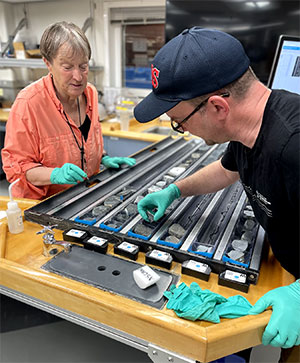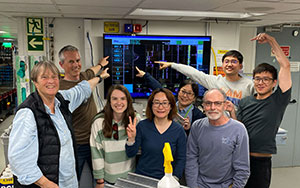UW Professor Part of Team That Recovered Section of Earth’s Mantle
Published June 12, 2023

In the early 1960s, geologists conceived of an idea to reach Earth’s mantle via Project MoHole, an effort to drill through Earth’s crust to obtain samples of the Mohorovičić discontinuity, or Moho -- the boundary between the crust and the mantle. At the time, it was seen as exciting as the possibility of American astronauts eventually walking on the moon.
Fast forward over 60 years, and the achievement of recovering a long section of Earth’s mantle has finally been accomplished. And a University of Wyoming researcher was part of International Ocean Discovery Program (IODP) Expedition 399 research team that contributed to this historic achievement. While the team did not actually drill across the Moho, it did obtain peridotite that originally came from the mantle brought to the surface by later faulting.
“We’ve finally recovered a long section of Earth’s mantle, and I am excited to be part of the team that did that,” says Barbara John, a professor in the UW Department of Geology and Geophysics, who was part of a research team aboard the JOIDES Resolution that drilled into mantle rocks between May 1 and June. “I’m elated. This is a true moment of history in the field of geology.”
Although this is not the first time the scientific community has recovered Earth’s mantle via drilling, these new cores provide the longest section of mantle ever recovered in situ from planet Earth, John adds.
The mantle makes up the bulk of Earth’s interior and lies between Earth’s dense, super-heated core and its thin outer layer, the crust. The mantle is about 2,900 kilometers -- or 1,802 miles thick -- and makes up 82 percent of Earth’s total volume, John says. The mantle is the source of magma for volcanoes and facilitates plate tectonics, the driving force for most earthquakes on Earth.
The mantle is made of a rock called peridotite, itself made of various proportions of the magnesium and iron-rich minerals olivine, orthopyroxene, clinopyroxene and spinel, forming what are called lherzolite (olivine, orthopyroxene and clinopyroxene), harzburgite (olivine and orthopyroxene) and dunite (olivine and spinel), John says. Mantle peridotite is what melts to produce the magma that fuels volcanoes such as those found on Hawaii and Iceland.
John says most of the mantle is buried beneath the crust and, therefore, almost inaccessible, both on the continents and in the oceans. The deepest core the research group recovered from the bottom of the hole was 4,157 feet below the seafloor.
“Recovery of mantle rocks at Atlantis Massif is truly exciting. We drilled rocks from Earth’s mantle, called peridotite, brought to the seafloor by large faults,” John says. “Imagine frosting -- Earth’s crust -- covering a cake -- the mantle. Now, cut a slice and lift it out, and the cake -- the mantle beneath -- is exposed.”
The Atlantis Massif, approximately the size of Mount Rainier, is an underwater mountain in the Atlantic Ocean. It is located at 30 degrees N. latitude on the Mid-Atlantic Ridge halfway between Morocco and Florida.

John was part of a three-person structural geology team -- with colleagues Rebecca Kuehn, a postdoctoral researcher at Martin Luther University of Halle-Wittenberg in Halle, Germany, and Andy Parsons, a postdoctoral research fellow in marine geoscience at the University of Plymouth in Plymouth, England.
They documented the character of deformation in the core. This includes all features from fractures and faults to older ductile structures that are sheared out much like taffy. Together, these features tell the story of how the mantle is brought to Earth’s surface and how the spreading of Earth’s tectonic plates is accommodated at this location on the Mid-Atlantic Ridge, John says.
“I will be looking at all of the structural data to better understand the processes that lead to the emplacement of the mantle to the seafloor and will be using a rare mineral zircon, present in the rocks, to determine the age of the intrusive, frozen magma found in the core,” John explains. “It’s clear, from looking at the rocks, that there is a complicated history of injection of magma into the mantle. I will try to decipher that sequence to better understand the history of our drilled section of rocks.”
John says microbiologists will analyze samples from the recovered core to recognize how deep microbes can live below Earth’s surface and for clues about how, before life originated on Earth, small organic molecules might have formed as rocks reacted with seawater.
“This could be a way that you go from just having basically water and rock that produces hydrogen molecules that can then combine with other organic molecules and lead to early life,” says Susan Lang, co-chief scientist of the expedition and a biogeochemist at Woods Hole Oceanographic Institution. “If organic molecules are found, it could help confirm that serpentinization of peridotite leads to their creation and may, therefore, contribute to our understanding of the origin of life on Earth.”
The JOIDES Resolution left Ponta Delgada in the Azores Islands, which is part of Portugal, April 14 and returned to Ponta Delgada June 8. The expedition lasted 56 days.
John applied to participate in this expedition based on her previous involvement as a co-chief scientist at Atlantis Massif with IODP in 2004-05 and, again, with on-bottom drilling to the same area in 2015.
“I was one of 10 U.S. scientists chosen to go on this expedition,” she says. “The research team onboard included 24 scientists, which was made up of geologists, geochemists, hydrologists and microbiologists from the U.S., Australia, China, France, Germany, India, Japan, Spain and the United Kingdom working together.”

